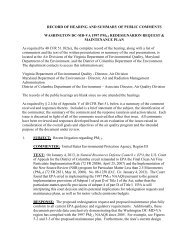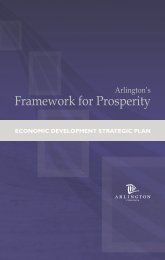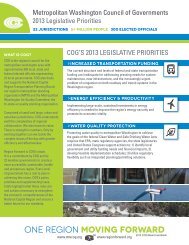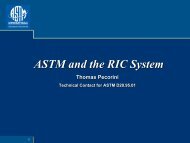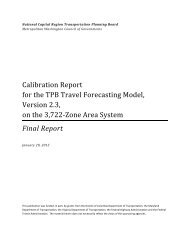PTI Local Government Energy Assurance Guidelines - Metropolitan ...
PTI Local Government Energy Assurance Guidelines - Metropolitan ...
PTI Local Government Energy Assurance Guidelines - Metropolitan ...
Create successful ePaper yourself
Turn your PDF publications into a flip-book with our unique Google optimized e-Paper software.
Case Study 1. PV Supporting Emergency AM Radio Transmissions<br />
KBET Radio, with assistance from Southern California Edison and the U.S. Department of<br />
<strong>Energy</strong>, installed a 10-kW grid-connected photovoltaic (PV) system at its new station building in<br />
Santa Clarita, 35 miles north of downtown Los Angeles. If a power outage occurs, the system will<br />
instantly become an emergency power source for the station’s AM radio transmitter. KBET is a<br />
key local Emergency Operations Center communications facility, providing a critical link between<br />
police, fire, and other disaster response contacts.<br />
Benefits of Renewable <strong>Energy</strong> to Key Assets<br />
Key assets that can benefit from the use of renewable energy technologies include “911” call centers, airports,<br />
emergency shelters, hospitals, first responder facilities (Emergency Operations Centers), water supply, and<br />
telecommunications infrastructure. Many cities are exploring renewable energy technologies such as photovoltaics<br />
for replacing or complementing traditional backup power supplies.<br />
Solar Technology Options<br />
Using solar power to produce electricity is not the same as using solar to produce heat. Solar thermal principles are<br />
applied to produce hot fluids or air. Photovoltaic principles are used to produce electricity. A solar (photovoltaic, or<br />
“PV”) panel is made of the natural element silicon, which becomes charged electrically when subjected to sunlight. 8<br />
In all there are three major solar technology areas:<br />
■ ■ Solar Photovoltaics: Photovoltaics are<br />
semiconductor devices that when exposed to the sun,<br />
create electricity. They are assembled into modules,<br />
and then placed on buildings, on the ground, or<br />
on parking structures. They can be tied into the<br />
electricity grid or used off-grid to power individual<br />
structures. There was a 40 percent increase in<br />
electricity grid-tied PV from 2008 to 2009.<br />
■ ■ Concentrated Solar Power (CSP): CSP uses lenses<br />
or mirrors to concentrate the sun’s rays on a small<br />
area. Four new CSP plants were connected to the grid<br />
in 2009, located in Hawaii, California, and Arizona.<br />
A CSP apparatus is shown in Figure 2.<br />
■ ■ Solar Thermal: Solar thermal technology uses the<br />
sun—via flat plates, tubes or collectors—to heat<br />
water to used for heating and cooling buildings, or<br />
provide hot water to the building tenants. Markets<br />
for solar thermal have grown each year since 2006,<br />
with a 40 percent increase in 2008 and a 10 percent<br />
increase in 2009. How can solar be used to cool a<br />
Figure 2. Concentrated Solar Power<br />
CSP in Kramer Junction, California<br />
Photo courtesy of NREL.<br />
8<br />
The Solar <strong>Energy</strong> Industries Association, September 2010.<br />
<strong>Local</strong> <strong>Government</strong> <strong>Energy</strong> <strong>Assurance</strong> <strong>Guidelines</strong> – Version 2.0 | 17



